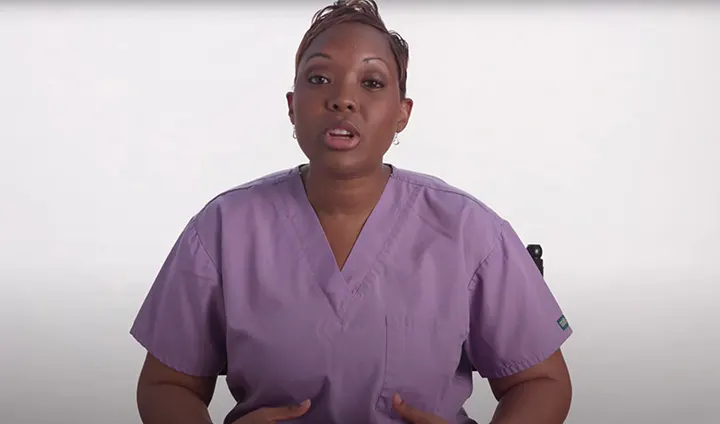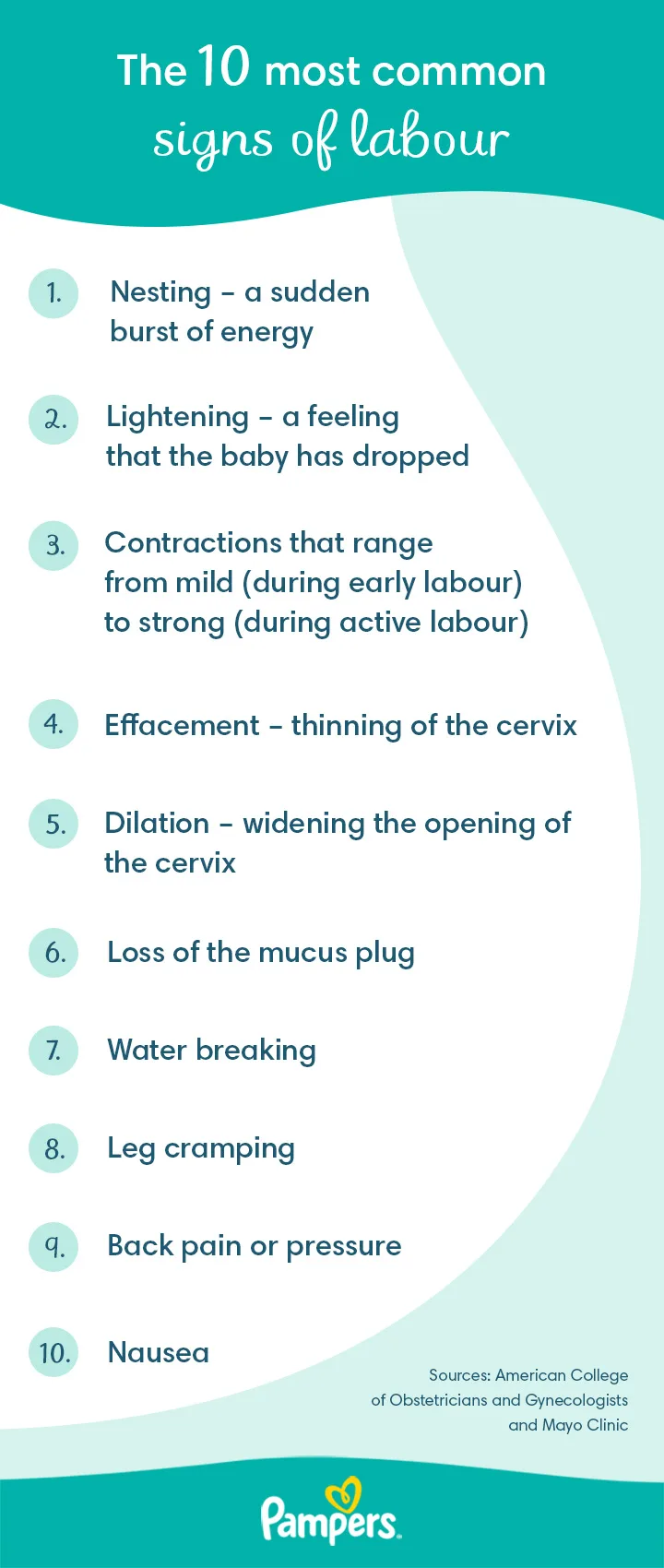Signs of Labour: Early Signs Labour Is Approaching
How does labour start? Is it when your water breaks? Is it when you feel contractions? Those are both sure signs that you’re in labour, but, sometimes, those initial and early signs of labour are more subtle. Rest assured your body almost always gives you the signals you need and the inner wisdom to recognize them. Learn about the stages of labour, the differences between true and false labour, the signs and symptoms of both early and active labour, and what to do when you think it’s baby time!
What Is Labour?
Labour, more commonly called childbirth, is the experience of delivering your baby from the warm and cozy home of your uterus to the outside world. You’ve probably been excitedly and anxiously awaiting this moment for quite some time, but it’s important to understand that labour is a slow, multistep process that’s unique for each pregnancy. That said, labour tends to follow a general pattern for most people. Knowing about what’s likely to happen can help you prepare for the big day ahead.
RELATED PREGNANCY TOOL
Baby Name Generator
Filter by gender:
Filter by theme:
When Does Labour Start?
Although your due date is usually calculated according to the average length of pregnancy, which is 40 weeks for a full-term pregnancy, don’t expect your baby to arrive on the dot. It’s not uncommon for labour to start before or after your due date!
Labour may begin earlier than 40 weeks, such as at week 38 or 39. However, going into labour before 37 weeks of pregnancy is called preterm labour. This sometimes stops on its own without leading to preterm birth but will always need immediate medical attention.
On the other hand, a pregnancy can last between 41 and 42 weeks, which is referred to as late term, and even last longer than 42 weeks, which is called post term. If your due date has come and gone, you may be eager for labour to begin. You might have heard of traditional methods of inducing labour, such as drinking castor oil, which has not shown to be effective. In fact, experts don’t recommend trying any kind of home remedy! So, if you’re concerned labour hasn’t started yet, the best thing to do is consult your healthcare provider.
Stages of Labour
Childbirth is broken down into three stages:
Labour. This first stage is divided into two phases, early labour and active labour. The main differences between the two phases are how your contractions feel and the timing of your contractions. Therefore, a sign of early labour is characterized by mild contractions, whereas active labour has stronger, more regular contractions.
Pushing and delivery of your baby. This stage is often shorter than the previous stage; however, this is the stage that requires more work from you, as you’ll be pushing to help your baby enter the wide world!
Delivery of the placenta. This is the shortest stage. You may still feel contractions, which help separate the placenta from the uterine wall and then move the placenta into the birth canal. A few pushes can help you deliver it, and once your uterus fully contracts, your labour is complete.
Signs and Symptoms of Labour
Is nausea a sign of labour, or maybe headaches or diarrhea? Labour is a different experience for every person and can vary from pregnancy to pregnancy, but there are some similarities, too. It helps to recognize what’s common but always consult your healthcare provider with questions or if you experience any other symptoms.
Here are the 10 most common signs of labour:
Nesting—a sudden burst of energy
Lightening—a feeling that the baby has dropped
Contractions that range from mild (during early labour) to strong (during active labour)
Effacement—thinning of the cervix
Dilation—widening the opening of the cervix
Loss of the mucus plug
Water breaking
Leg cramping
Back pain or pressure
Nausea.
Learn more about these signs and symptoms of labour in the following two sections, which cover the two phases (early and active labour) in stage one.
Signs and Symptoms of Early Labour
Signs of early labour can be unpredictable in terms of duration. It may be hours or even days before you progress to active labour, especially if this is your first baby. (This time will usually become shorter with subsequent deliveries.) Until your contractions become more regular and more intense, or your water breaks, try to stay relaxed—active labour will eventually start.
Although every pregnancy is different, you may experience the following signs of early labour, some more subtle than others:
Nesting. It’s perfectly normal to experience a sudden surge of energy in the days or weeks before labour, a sign that it is coming! You might also have the urge to “nest” and prepare your home for the baby. Although nesting can begin any time during your pregnancy, many experience it just before labour starts. Don’t overexert yourself—try to take it easy.
Lightening. Your baby drops lower into your pelvis in the weeks, days, or hours before labour. This is called lightening because you may feel lighter, and find breathing a little easier, after the baby drops and isn’t pressing on your diaphragm.
Mild contractions. You may feel mild contractions that occur 5 to 15 minutes apart and last for between 60 and 90 seconds, one of the top signs of early labour. The pain or pressure that you feel may start in your back and move down to your abdomen. The contractions may be less than five minutes apart by the end of early labour.
Effacement. Your cervix thins, softens, and shortens completely before vaginal delivery. You may feel mild contractions or nothing at all.
Dilation. Your cervix begins to widen and open until it’s fully dilated. Dilation is an early sign that labour is approaching, as it starts slowly at first but speeds up once you’re in active labour.
Loss of your mucus plug. You might notice a thick, pinkish or blood-streaked vaginal discharge sometimes called a bloody show. This is what sealed your cervix during pregnancy. It often appears several days before labour begins, although it’s not always noticeable.
Signs and Symptoms of Active Labour
Active labour is when things really start to happen—and when you should head to the hospital. Active labour can last from four to eight hours, and sometimes even longer. By this time, your cervix may likely be dilated from 6 to 10 centimetres, and you will notice stronger signs and symptoms that you’re in labour:
Water breaking. The fluid-filled amniotic sac that surrounded your baby during pregnancy may rupture several hours before or during labour. You may feel a discharge of watery fluid that comes as a trickle or a gush.
Strong and regular contractions. As your uterus begins to contract more frequently before active labour, you may feel pain in your back or pelvis. The contractions will be more regular and closer together, as close as three minutes, with each one lasting around 45 seconds. Timing your contractions can help you keep track of your progress.
Leg cramps. You may feel your legs cramp when you go into active labour.
Back pain or pressure. You could experience backache or a heavy, achy feeling as the pressure on your back increases.
Nausea. Some experience a feeling of nausea as active labour begins.
True Labour Vs. False Labour
Sometimes you may feel as if you’re going into labour, but it’s not real labour. So, how can you tell the difference between the signs of true and false labour (known as Braxton Hicks contractions)? A tried-and-true method of telling the difference is by timing the contractions and making note of whether the contractions go away when you move.
Use the table below to help distinguish between true and false labour:
| True Labour | False Labour |
|---|---|
| Contractions are regular and follow a predictable pattern (such as every 8 minutes). | Contractions are irregular and unpredictable, occurring, for example, in intervals of 10 minutes, then 6 minutes, 2 minutes, 8 minutes, etc. |
| You experience three types of progression: contractions become more frequent, longer lasting, and stronger. | No progression is seen over time in the closeness of the contraction intervals, length, or strength of the contractions. |
| Each contraction is felt starting at the lower back, radiating around to the front, low in the groin. | Contractions are felt in the front. |
| A change in activity or position won’t slow or stop contractions. | A change in activity or position may cause contractions to slow or stop. |
| Your healthcare provider will notice your cervix softening, thinning, or dilating. | No cervical changes occur. |
What to Do When You Notice Signs of Early Labour Coming
In the early stages, with only a few signs of labour, you may not need to go to the hospital just yet. Labour can take a lot of time, and you’ll may be more comfortable and perfectly safe staying at home. If at any point you’re concerned about what you’re experiencing, contact your healthcare provider. Realizing you’re in labour can bring feelings ranging from excitement to disbelief or apprehension. Try to stay calm and focused. Arrange to have your partner or friend with you to help record labour symptoms, keep you company, and get you to the hospital when the time comes. You can also try to ease any discomfort by
getting up and going for a walk
trying some relaxation or breathing techniques you learned in your prenatal class
changing positions
taking a shower or a bath.
When to Call Your Healthcare Provider and Go to the Hospital
If you’ve noticed the signs of early or active labour but have any doubt about whether it’s really happening, call your healthcare provider for advice. However, be sure to call your healthcare provider or go to the hospital if you’re experiencing any of these signs:
Your water has broken but you’re not experiencing any contractions, and especially if the fluid is green or brown, or has a foul odour
You notice bright red vaginal bleeding (not pale pink or dark brown discharge of the mucus plug) coupled with abdominal pain
You have a headache, vision problems, or sudden swelling—all of which may indicate a complication called preeclampsia
You’re in constant severe pain without any feelings of relief between contractions
You feel your baby move less
You believe you may be in preterm labour.
FAQS AT A GLANCE
Signs of early labour may indicate that labour is coming or has begun. These signs can include:
- Nesting, which is a sudden burst of energy to get everything ready before your baby arrives.
- Lightening, when your baby drops lower into your pelvis, relieving some pressure from your diaphragm.
- Mild contractions that you may feel in your back and abdomen that happen 5 to 15 minutes apart and last for between 60 and 90 seconds.
- Effacement, when your cervix thins, softens, and shortens.
- Dilation, when your cervix begins to open.
- Loss of your mucus plug, which you’ll notice as a thick, pinkish or blood-streaked vaginal discharge.
The Bottom Line
As your due date approaches, keep an eye out for the early signs and symptoms of labour and have your birth plan ready. It’s very unlikely that you will suddenly go into labour without warning—your body will likely let you know that you’re close to the big day! Knowing you’re prepared will help reduce anxiety when you notice those first signs of labour, whether at 37 weeks, 38 weeks or earlier or later. You’re nearing the end of your pregnancy, and you’re about to bring your baby into the world. You can do this! In the meantime, relieve anxiety by stocking up on diapers to get rewards with the Pampers Club app.
Join Pampers Club and get:






